PART 1: A BEGINNER’S GUIDE TO AUSTRALIAN TRUCK TERMS

 If you’re a newbie to the world of trucking, it’s more than likely you’ve stumbled across one or two truck terms you’re not sure about – but don’t sweat it, we’re here to help! Before you get on the road to make that all-important first truck purchase or visit a dealership, take five minutes to catch up on some popular truck terms worth getting your head around. Keen to know more? We talk payloads and powertrains in our follow-up post: Part 2: A beginner’s guide to Australian truck terms.
If you’re a newbie to the world of trucking, it’s more than likely you’ve stumbled across one or two truck terms you’re not sure about – but don’t sweat it, we’re here to help! Before you get on the road to make that all-important first truck purchase or visit a dealership, take five minutes to catch up on some popular truck terms worth getting your head around. Keen to know more? We talk payloads and powertrains in our follow-up post: Part 2: A beginner’s guide to Australian truck terms.
Axle capacity (or loading limit)
Trucks can have a range of axle configurations such as single, twin steer and tandem. Your axle capacity is set by the manufacturer and lets you know the weight your front or rear axles can safely support. Suspension and tyre capacities will also make a difference. The loading limit on any given axle or group of axles depends on the "weakest link", and also on the legal limit. So check in with the regulatory authorities and the specifications of your truck to be clear on your loading limits.
Differential
The differential might not be the most raved about device on your truck but it’s really important for getting the engine power transferred to the road. The differential is the set of gears in an axle that allows outside wheels to travel faster than the inside wheels – as outside wheels have further to travel when you’re turning. Without it, one of your wheels would have to skid and that would mean more wear and tear on your tyres, the road and ultimately your truck’s driveline!
Engine Displacement
Your engine displacement measures the volume of the air and fuel mixture the pistons in your engine can draw in. Often referred to in cubic centimetres (cc) or Litres (L), the greater your engine displacement the greater amount of fuel and oxygen you can burn per piston stroke, which generally translates as more power. Of course, modern turbocharged engines with sophisticated electronic controls can compress the air and fuel mixture efficiently to give more power than in the "old days".
Gross Vehicle Mass (GVM)
The GVM is one number you will definitely want to know about your new truck. Set by the manufacturer, the GVM rating is the maximum weight your truck can carry (including its own weight). Usually specified in kilograms (kg) or tonnes (t, where 1 t = 1,000 kg), the GVM includes the weight of the chassis, body, payload, fuel, passengers and any extras such as tools and additional equipment. Be aware that the GVM rating from the manufacturer can exceed the legal GVM limit in your state, so always stay within the legal limit for your truck. To work out the weight of goods you can legally carry on your truck; check out our definition on payload in Part 2: Six terms you should before buying a new truck.
Gradeability
If your trucks will tackle some hilly terrain during the average working day then gradeability is something you’ll want to chat about with your dealer. Gradeability is generally measured as a percentage, and lets you know the steepest grade your truck can climb while in its lowest gear and under load.
Power
Feeling power hungry? You’ll need to get the right power and torque for the job. While torque tells you how your truck will perform when starting up and under heavy load, power dictates how quickly you can get to speed. If you won’t be towing heavy loads too often and are more concerned with how quickly you can get from A to B, higher power (over higher torque) is probably what you’ll need to look for. Your truck’s power will be given by the manufacturer as either: Kilowatts at revolutions per minute (kW @ RPM) kW are the official metric units for power, so will be shown on all vehicle manufacturer's specification sheets Horse power at revolutions per minute (HP @ RPM) HP are sometimes referred to as "Imperial HP" or "British HP". PS at revolutions per minute (PS @ RPM) PS (shortened from the German Pferdestärke, which can be translated into English literally as horse power) are often referred to as "European horse power". PS was the metric unit for power until the kW was officially declared in 1972. Approximate conversions: 1.0 kW = 1.36 PS = 1.34 HP Keen to know more? Check out Part 2 of our beginner’s guide to Australian truck terms here.


Playtime’s over, get $3,500* to spend on extras.
If you’re ready to get serious about tackling bigger jobs, grab yourself an NLR 45-150 AMT SWB Traypack from the Ready-to-Work range for $62,990 drive away*. And to prove we aren’t playing, buy any NLR Traypack before June 30 and you’ll get $3,500* to spend on genuine accessories or an Essentials service agreement.
Learn more



